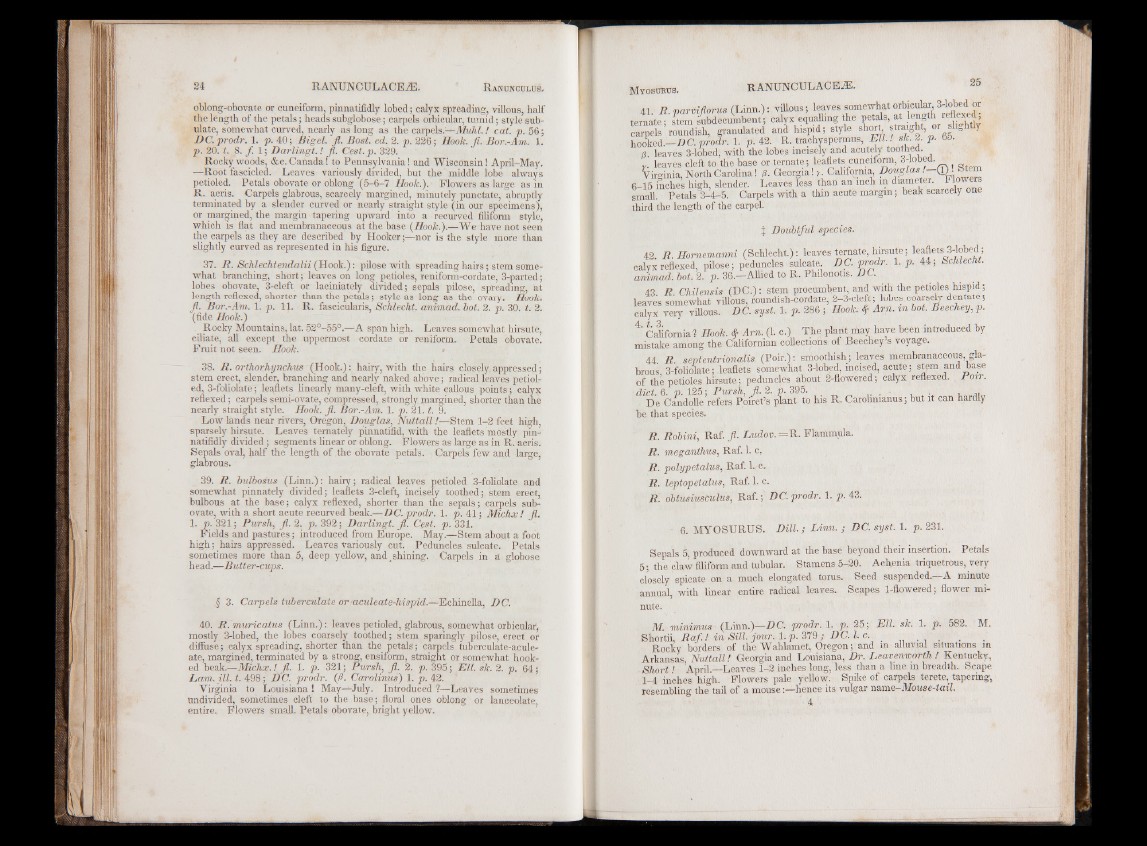
oblong-obovate or cuneiform, pinnatifidly lobed; calyx spreading, villous, half
the length of the petals; heads subglobose; carpels orbicular, tumid; style subulate,
somewhat curved, nearly as long as the carpelsfl-Muhl.! cat. p. 56;
DC. prodr. 1. p. 40; Bigel. fl. Bost. ed. 2. p. 226; Hook. ft. Bor.-Am. 1.
p. 20. t. 8. f 1; Darlingt.! ft. Cest.p. 329.
Rocky woods, &c. Canada! to Pennsylvania! and Wisconsin! April-May.
—Root fascicled. Leaves variously divided, but the middle lobe always
petioled. Petals obovate or oblong (5-6-7 Hook.'). Flowers as large as in
R. acris. Carpels glabrous, scarcely margined, minutely punctate, abruptly
terminated by a slender curved or nearly straight style (in our specimens),
or margined, the margin tapering upward into a recurved filiform style,
which is flat and membranaceous at the base (Hook.).—We have not seen
the carpels as they are described by Hooker;—nor is the style more than
slightly curved as represented in his figure.
37. R. Schlechtendalii (Hook.): pilose with spreading hairs; stem somewhat
branching, short; leaves on long petioles, reniform-cordate, 3-parted;
lobes obovate, 3-cleft or laciniately divided; sepals pilose, spreading, at
length reflexed, shorter than the petals; style as long as the ovary. Hook.
fl. Bor.-Am. 1. p. 11. R. fascicularis, Schlecht. animad. hot. 2. p. 30. t. 2.
(fide Hook.)
Rocky Mountains, lat. 52°-55°.—A span high. Leaves somewhat hirsute,
eiliate, all except the uppermost cordate or reniform. Petals obovate.
Fruit not seen. Hook. _ . •
38. R . orthorhynchus (Hook.): hairy, with the hairs closely,appressed;
stem erect, slender, branching and nearly naked above; radical leaves petioled,
3-foliolate; leaflets linearly many-cleft, with white callous points; calyx
reflexed; carpels semi-ovate, compressed, strongly margined, shorter than the
nearly straight style. Hook. fl. Bor.-Am. 1. p. 21. t. 9.
Low lands near rivers, Oregon, Douglas, Nuttall !■—Stem 1-2 feet high,
sparsely hirsute. Leaves ternately pinnatifid, with the leaflets mostly pin-
natifidly divided ; segments linear or oblong. Flowers as large as in R. acris.
Sepals oval, half the length of the obovate petals. Carpels few and large,
glabrous.
39. R. bulbosus (Linn.): hairy; radical leaves petioled 3-foliolate and
somewhat pinnately divided; leaflets 3-cleft, incisely toothed; stem erect,
bulbous at the base; calyx reflexed, shorter than the sepals; carpels sub-
ovate, with a short acute recurved beak.— DC. prodr. 1. p. 41; Michx! fl.
1. p. 321; Pursh, fl. 2. p. 392; Darlingt. fl. Cest. p. 331.
Fields and pastures; introduced from Europe. May.—Stem about a foot
high; hairs appressed. Leaves Variously cut. Peduncles sulcate. Petals
sometimes more than 5, deep yellow, and shining. Carpels in a globose
head.—Butter-cups. §
§ 3. Carpels tuberculate or'aculeate-hispid.—Echinella, DC.
40. R. muricatus (Linn.): leaves petioled, glabrous, somewhat orbicular,
mostly 3-lobed, the lobes coarsely toothed; stem sparingly pilose, erect or
diffuse; calyx spreading, shorter than the petals; carpels tuberculate-acule-
ate, margined, terminated by a strong, ensiform, straight or somewhat hooked
beak.—Michx.! ft. 1. p. 321; Pursh, fl. 2. p. 395; Ell. sk. 2. p. 64;
Lam. ill. t. 498; DC. prodr. (fl. Carolinus) 1. p. 42.
Virginia to Louisiana 1 May—July. Introduced ?—Leaves sometimes
Undivided, sometimes cleft to the base; floral ones oblong or lanceolate,
entire. Flowers small. Petals obovate, bright yellow.
41 R narviflorus (Linn.): villous; leaves somewhat orbicular 3-lobed or
ternate; Jem subdecumbent; calyx equalling the petals,
c a r p e l s roundish, granulated and hispid; style short straight, or shghtly
hooked.-—DC. prodr. 1. p. 42. R. trachyspermus, Ell. sk. 2. p. bo.
B leaves 3-lobed, with the lobes mcisely and acutely toothed,
v.' leaves cleft to the base or ternate; leaflets cuneiform, 3-lobed.
V i r g i n i a , North Carolina! B. Georgia!).. California Douglas!—\(D ,s t em
6-15 inches high, slender. Leaves less than an inch m diameter. Flowers
small. Petals 3-4-5. Carpels with a thin acute margin; beak scarcely one
third the length of the carpel.
$ Doubtful species.
42 R. Hornemanni (Schlecht.): leaves ternate, hirsute; leaflets 3-lobed,
calyx reflexed, pilose; peduncles sulcate DC. prodr. 1. p. 44; Schlecht.
animad. bot. 2. p. 36.—Allied to R. Philonotis. DC.
43. R.Chilensis (DC.): stem procumbent, and with the petioles hispid;
leaves somewhat villous, roundish-cordate, 2-3-cleft; lobes coarsely dentate,
calyx very villous. DC. syst. 1. p. 286 ; Hook, f Am . m bot. Beechey,p.
4 ’ California'2 Hook, f Am. (1. c.) The plant may have been introduced by
mistake among the Californian collections of Beechey’s voyage.
44 R. septentrionalis (Poir.): smoothish; leaves membranaceous, glabrous
3-foliolate; leaflets somewhat 3-lobed, incised, acute; stem and base
of thé petioles hirsute; peduncles about 2-flowered; calyx reflexed. Poir.
diet 6. p. 125; Pursh, fl.2 . p.395. . - .
De Candolle refers Poiret’s plant to his R. Carolmianus; but it can liardiy
be that species.
R . Robini, Raf. fl. Ludov. = R . Flammula.
R. meganthus, Raf. 1. c,
R. polypetalus, Raf. 1. c.
R. leptopetalus, Raf. 1. e.
R. obtusiusCulus, Raf.,; DC. prodr. 1. p. 43.
- 6. MYOSURUS. D ill.; Linn. ; DC. syst. 1. p. 231.
Sepals 5, produced downward at the base beyond their insertion. Petals
5; the claw filiform and tubular. Stamens 5—20. Acflenia triquetrous, very
closely spicate on a much elongated torus. Seed suspended.—A minute
annual, with linear entire radical leaves. Scapes 1-flowered; flower mi-
nute.
ikf. minimus*\ (Linn.)—DC. pvodv. 1. p.. 2 5 \ Ell. sk. 1. p. 582. M.
Shortii, R a f ! in Sill. jour. 1 .p . 379; DC. 1. c. . - . ’
Rocky borders of the Wahlamet, Oregon; and m alluvial situations m
Arkansas Nuttall! Georgia and Louisiana, Dr. Leavenworth ! Kentucky,
Short 1 'April.—Leaves 1-2 inches long, less than a line in breadth. Scape
1-4 inches high. Flowers pale yellow. Spike of carpels terete, tapering,
resembling the tail of a mouse:—hence its vulgar oame-Mouse-tail.
Mg